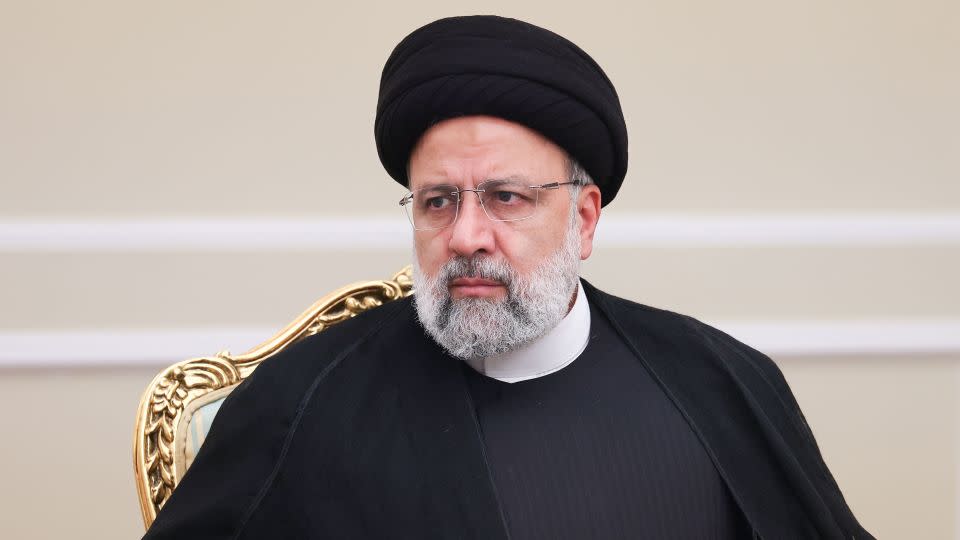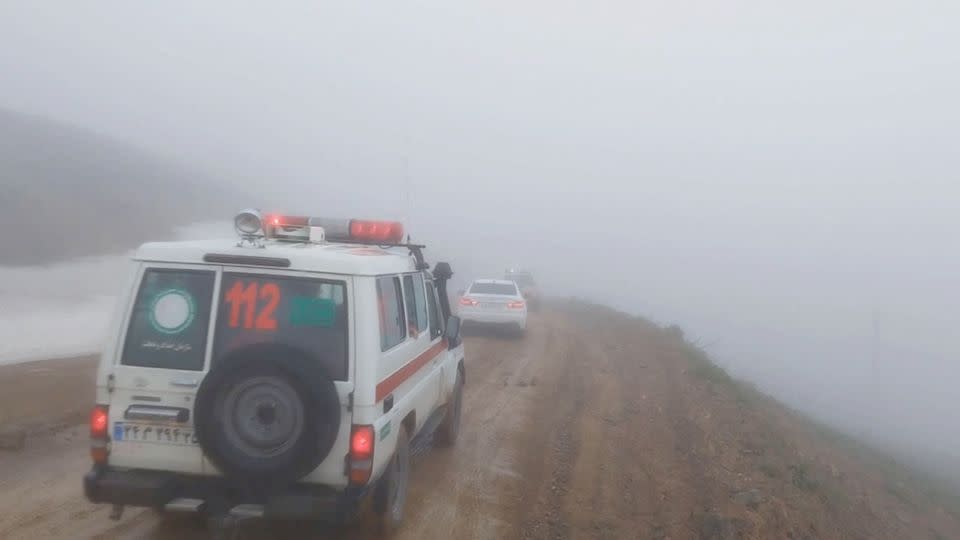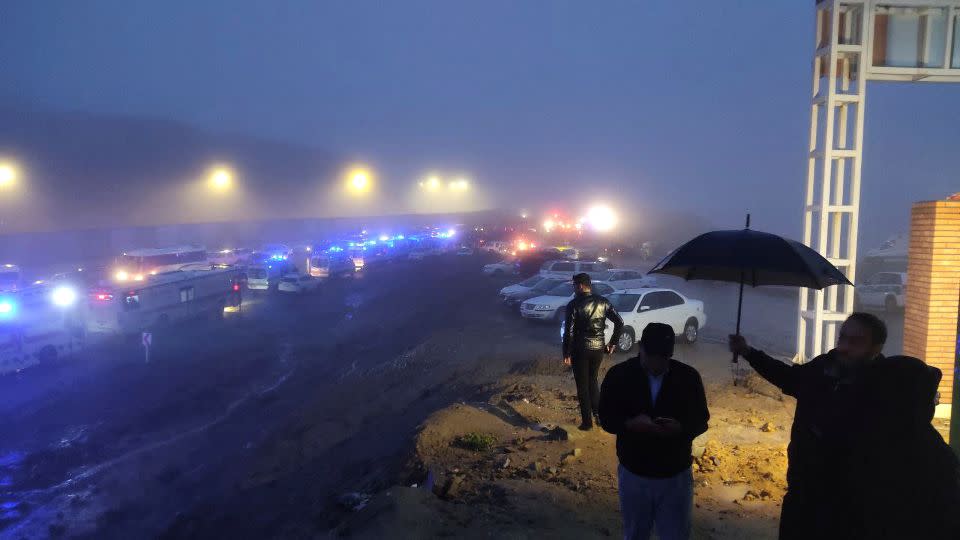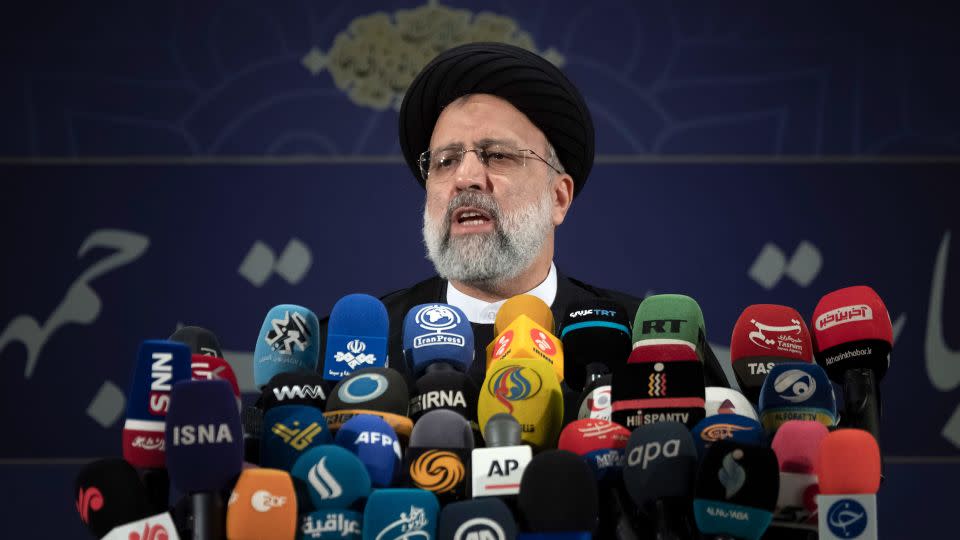Iranian President Ebrahim Raisi and foreign minister confirmed dead in helicopter crash
- Oops!Something went wrong.Please try again later.
- Oops!Something went wrong.Please try again later.
Ultraconservative Iranian President Ebrahim Raisi was killed Sunday, along with his foreign minister, in a helicopter crash in Iran’s remote northwest, injecting fresh uncertainty as the country’s hardline clerical establishment navigates rising regional tensions and domestic discontent.
The loss of two of Iran’s most influential political figures comes as the country buckles under significant economic and political strain, with tensions with nearby Israel at a dangerous high.
Drone footage of the helicopter wreckage taken by the Red Crescent and carried on Iranian state media showed the crash site on a steep, wooded hillside, with little remaining of the helicopter beyond a blue and white tail.
Iranian Supreme Leader Ayatollah Khamenei – the final arbiter of domestic and foreign affairs in the country – announced five days of public mourning and confirmed that Iran’s First Vice President, Mohammad Mokhber, is now managing the executive branch.

Sunday’s crash occurred as Raisi, 63, and Foreign Minister Hossein Amir-Abdollahian were returning from a ceremony for an opening of a dam on Iran’s border with Azerbaijan, state media reported.
Among those onboard were three crew members, the governor of Eastern Azerbaijan province, an imam, Raisi’s head of security chief and a bodyguard, according to IRGC-run media outlet Sepah.
The crash prompted an hours-long search-and-rescue operation with assistance from the European Union and Turkey among others, but emergency crews were hampered by the thick fog and plummeting temperatures.
CNN confirmed the geolocation of the crash site to the mountainous region in Varzeghan, near the village of Uzi, in Iran’s East Azerbaijan province.
The death of Raisi comes at a sensitive time domestically for Tehran and seven months into Israel’s war against Hamas in Gaza that has sent tensions soaring throughout the Middle East — and brought a decades-long shadow war between Israel and Iran out into the open.
Last month, Iran launched an unprecedented drone and missile attack on Israel — its first ever direct attack on the country — in response to a deadly apparent Israeli airstrike on Iran’s consulate in Damascus.
Under Raisi, Iran’s hardline leadership has faced significant challenges in recent years, convulsed by youth-led demonstrations against clerical rule and grim economic conditions. Iranian authorities have launched a widening crackdown on dissent since nationwide protests broke out over the 2022 death of a young woman in the custody of the country’s notorious morality police.
Following the official announcement of Raisi’s death Monday, Iran’s government convened an “urgent meeting” as the clerical establishment, headed by Khamenei, prepare to appoint a new president they can throw their support behind.

The Iranian constitution also mandates that the three heads of the branches of government, including the Vice President, speaker of the parliament, and head of the judiciary, must arrange for an election and elect a new leader within 50 days of assuming the role of acting President.
In a statement Monday, the president’s cabinet praised Raisi as a “hard-working and tireless” president who served the people of Iran to help advance and progress the country. “[He] stood by his promise and sacrificed his life for the nation,” the statement said.
The cabinet, seeking to affirm calm in the country, also insisted there “will not be the slightest disturbance” in the administration of Iran in the wake of the deadly crash.
On Monday, Iranian state broadcasters took to airing Islamic prayers in between news broadcasts, while a photo shared by IRNA showed that the chair that Raisi usually sits in was vacant and draped with a black sash in memory of the president.

A president groomed for real power
Raisi came to Iran’s presidency from the judiciary, where he drew attention from both the Iranian clerical elite and Western critics for his hardline approach to dissent and human rights in the country.
In 2019 — the same year that Raisi became Iran’s chief justice — he was sanctioned by the US, citing his participation in the 1988 “death commission” as a prosecutor and a United Nations report on the judicial execution of at least nine children between 2018 and 2019.
The Center for Human Rights in Iran (CHRI) has accused him of crimes against humanity for being part of the committee that oversaw the execution of up to 5,000 political prisoners in 1988. Raisi has never commented on these allegations.
For Iran’s ruling establishment, though, Raisi seemed to be made in the image of the 1979 Islamic Revolution’s ideals, a guarantor of its continuation even as many chafed under its ultraconservative rules.
In 2021, he was elected to the presidency in a contest heavily engineered by the Islamic Republic’s political elite so that he would run virtually unchallenged. Raisi’s inauguration was seen to signal the start of a new harder-line era in Iran.
Many activists accused Iran’s clerical establishment of “selecting” rather than electing the next president in a poll designed to further entrench the power of the country’s hardline clerical rulers, despite the public’s calls for reforms. Overall voter turnout was 48.8% – the lowest since the establishment of the Islamic Republic.

He took the presidency as negotiations with the United States over how to revive the 2015 nuclear deal stalled, and as the country was in the throes of an economic crisis and under mounting pressure to reform.
As President, Raisi is widely seen as a figure in which the Iranian clerical establishment has heavily invested – and even as a potential successor to the 85-year-old Khamenei. Many believe he has been groomed to be elevated to the Supreme Leadership.
A year into his presidency, he brutally quashed a youth-led uprising over repressive laws, such as the compulsory hijab, and continued to stamp out dissent in its aftermath. As recently as this month, a dissident rapper was handed a death sentence in releation to the 2022 protests.
A United Nations report found that Iran’s “repression of peaceful protests” and “institutional discrimination against women and girls” has led to human rights violations, some of which amount to “crimes against humanity.”
In foreign policy, Raisi notably presided over the strongest Iran-backed show of force against Israel in nearly two decades. Since the start of the Israel-Hamas war in October, Tehran-supported armed groups in Lebanon, Iraq and Yemen have continuously attacked Israel and its allies in the region.
He also spurned negotiations with the US over Iran’s nuclear program, dealing a devastating blow to stalled talks with the Biden administration that aimed to revive the Obama-era deal of sanctions relief in exchange for curbs to the country’s uranium enrichment program. That deal was upended by Trump in 2018, when the former president unleashed waves of sanctions on Iran despite Tehran ostensibly sticking to its end of the bargain.
Shortly after, the country announced its intention to enrich uranium up to 60% purity, pushing the country closer to reaching the 90% enrichment level that is considered weapons-grade. In March 2023, uranium particles enriched to near bomb-grade levels were found at an Iranian nuclear facility, according to the UN’s nuclear watchdog, as the US warned that Tehran’s ability to build a nuclear bomb was accelerating.
As he turned his back to Washington, Raisi sought to end his country’s economic isolation by looking elsewhere, strengthening Tehran’s relationship with China, and repairing diplomatic ties with Saudi Arabia and the UAE, Gulf Arab powerhouses which were long considered Tehran’s arch-foes.
Iran’s economy has begun to rebound over the past two years, according to the World Bank. But the nation remains shackled by sanctions, its social movements brutally repressed, and its political structure now shaken by Raisi’s sudden death.
This is a developing story and will be updated.
Correction: This article has been updated to remove a reference to former President Hassan Rouhani running in the 2021 election.
For more CNN news and newsletters create an account at CNN.com

